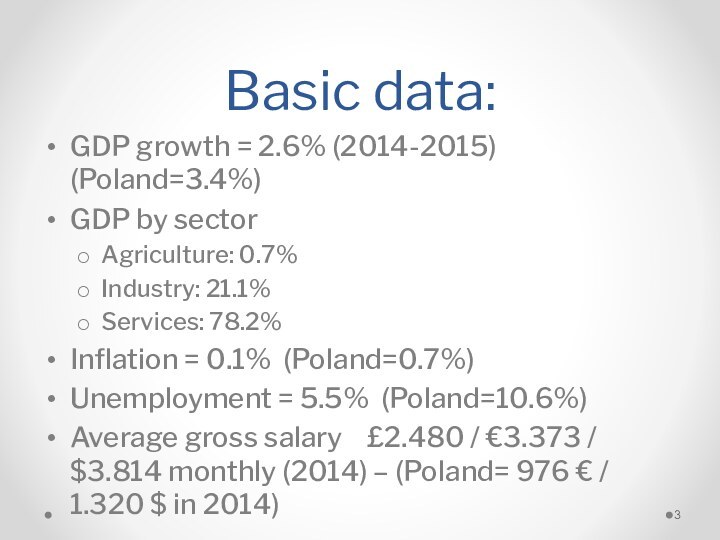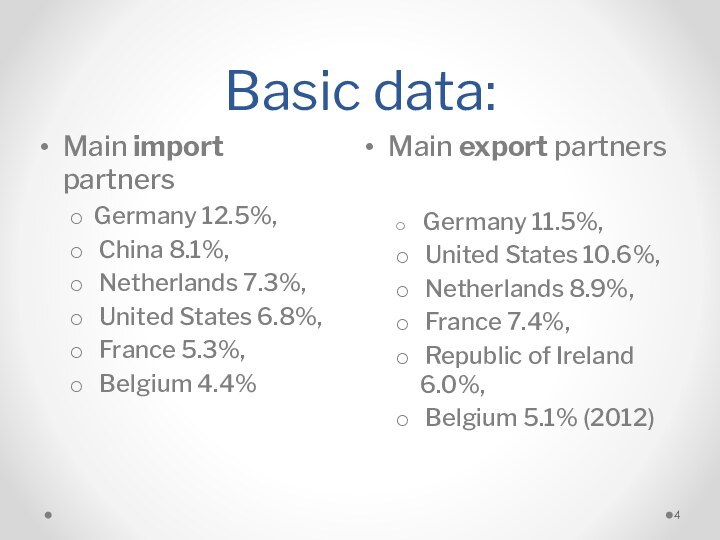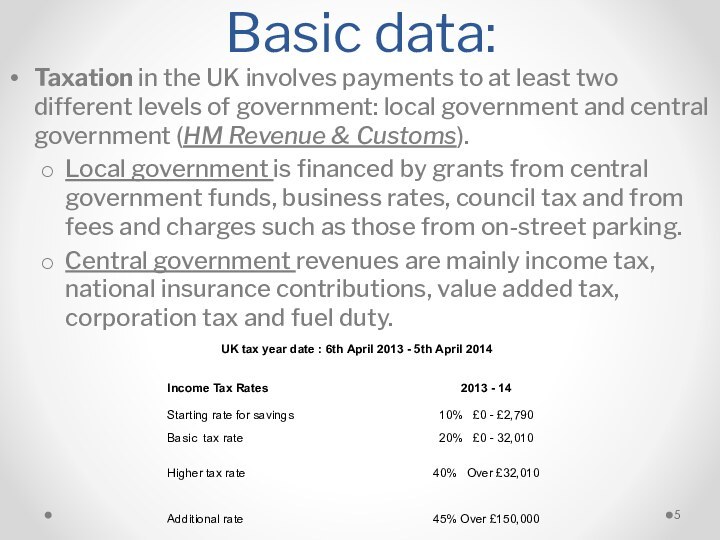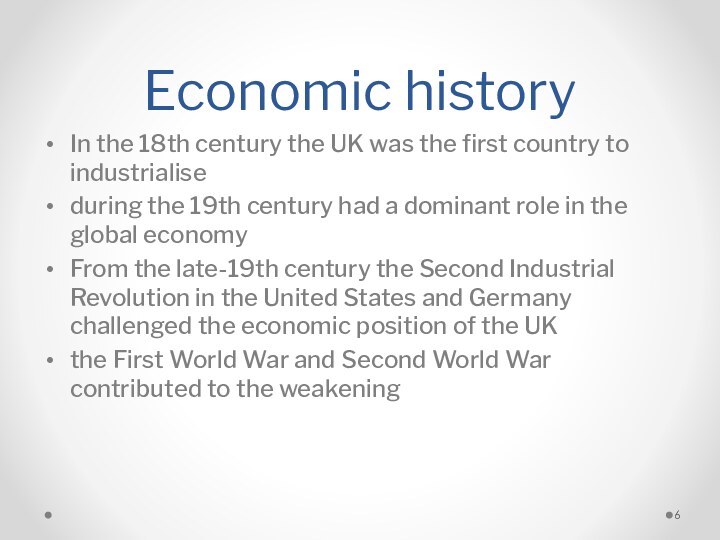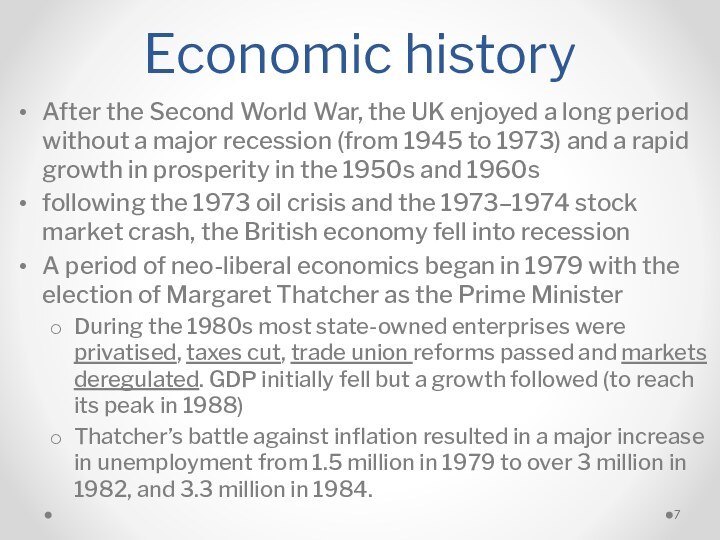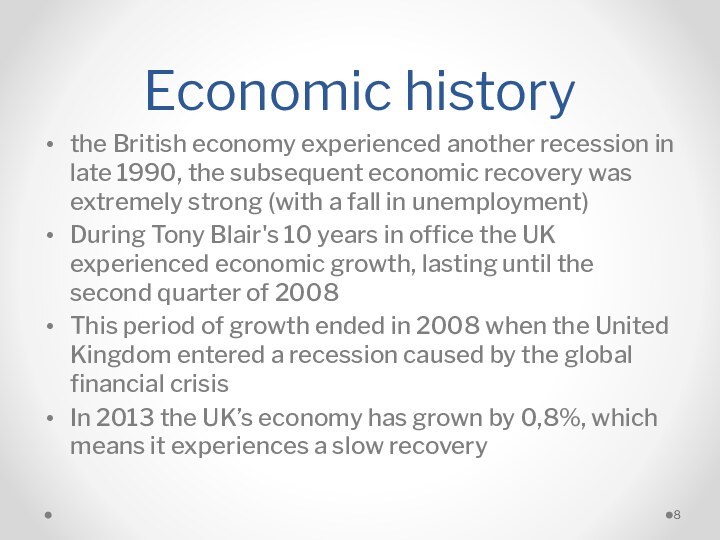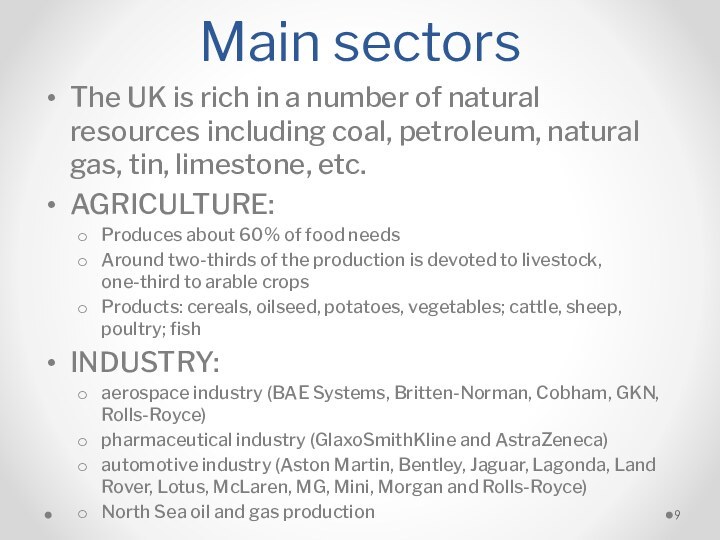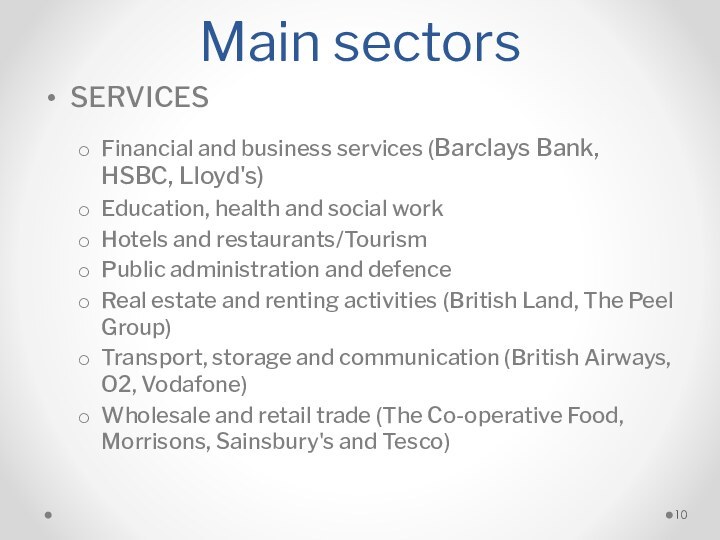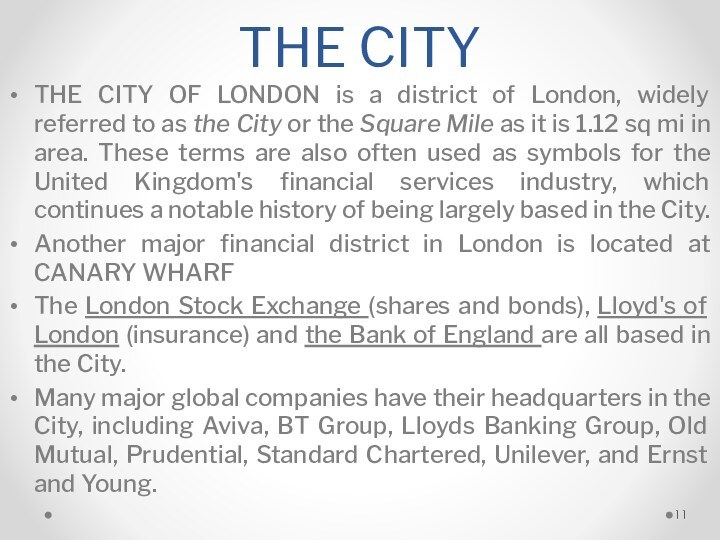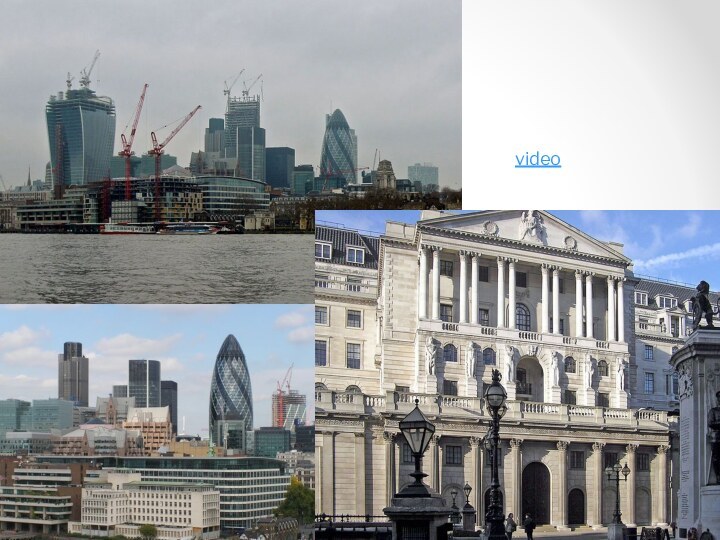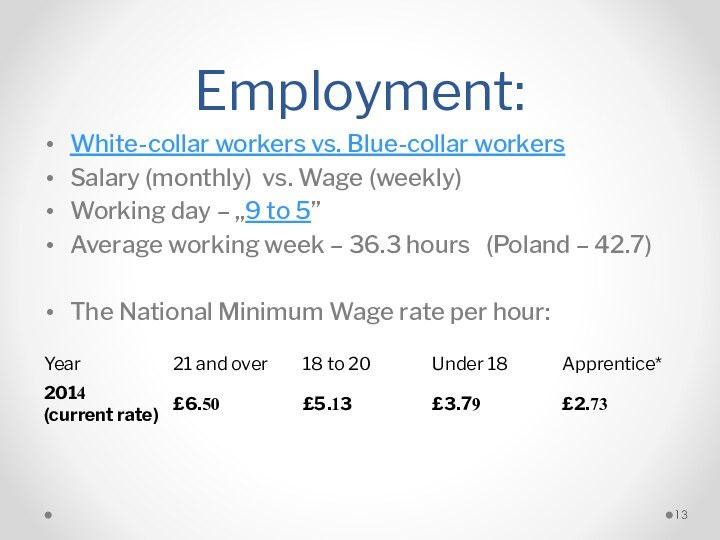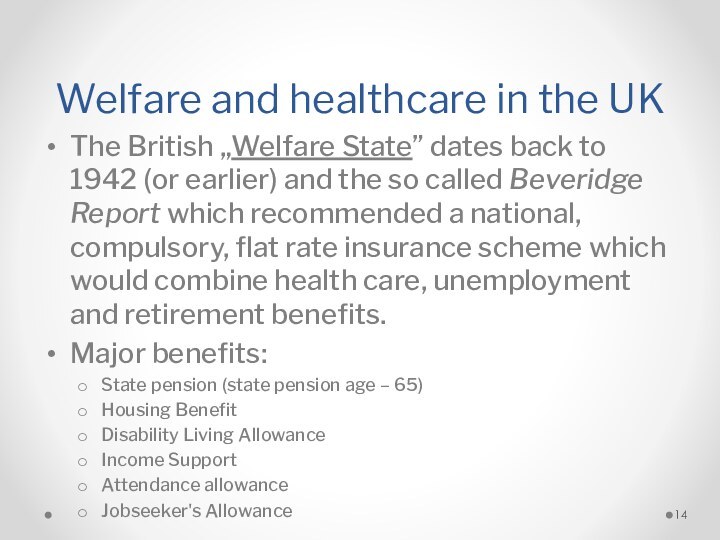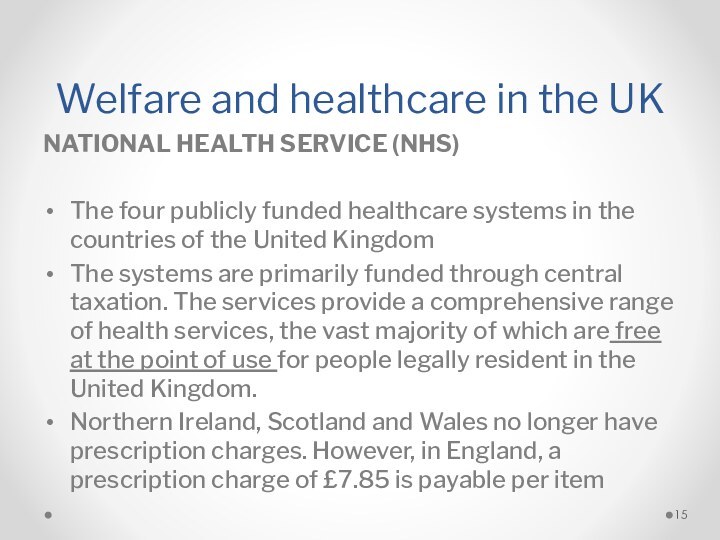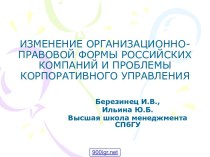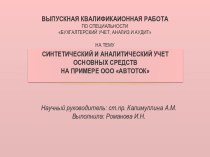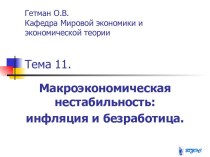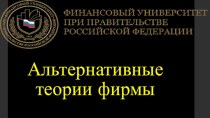Слайд 2
Basic data:
The national economy of The United Kingdom
is:
the 6th largest in the world*
The 3rd largest
in Europe*
The UK's GDP per capita ($36,941; Poland=$21,310) is the 22nd-highest in the world
In 2012, the UK was the 11th-largest exporter in the world and the 6th-largest importer
* measured by nominal GDP (Gross Domestic Product)
Слайд 3
Basic data:
GDP growth = 2.6% (2014-2015) (Poland=3.4%)
GDP by
sector
Agriculture: 0.7%
Industry: 21.1%
Services: 78.2%
Inflation = 0.1% (Poland=0.7%)
Unemployment =
5.5% (Poland=10.6%)
Average gross salary £2.480 / €3.373 / $3.814 monthly (2014) – (Poland= 976 € / 1.320 $ in 2014)
Слайд 4
Basic data:
Main export partners
Germany 11.5%,
United
States 10.6%,
Netherlands 8.9%,
France 7.4%,
Republic of Ireland
6.0%,
Belgium 5.1% (2012)
Main import partners
Germany 12.5%,
China 8.1%,
Netherlands 7.3%,
United States 6.8%,
France 5.3%,
Belgium 4.4%
Слайд 5
Basic data:
Taxation in the UK involves payments to
at least two different levels of government: local government
and central government (HM Revenue & Customs).
Local government is financed by grants from central government funds, business rates, council tax and from fees and charges such as those from on-street parking.
Central government revenues are mainly income tax, national insurance contributions, value added tax, corporation tax and fuel duty.
Слайд 6
Economic history
In the 18th century the UK
was the first country to industrialise
during the 19th century
had a dominant role in the global economy
From the late-19th century the Second Industrial Revolution in the United States and Germany challenged the economic position of the UK
the First World War and Second World War contributed to the weakening
Слайд 7
Economic history
After the Second World War, the
UK enjoyed a long period without a major recession
(from 1945 to 1973) and a rapid growth in prosperity in the 1950s and 1960s
following the 1973 oil crisis and the 1973–1974 stock market crash, the British economy fell into recession
A period of neo-liberal economics began in 1979 with the election of Margaret Thatcher as the Prime Minister
During the 1980s most state-owned enterprises were privatised, taxes cut, trade union reforms passed and markets deregulated. GDP initially fell but a growth followed (to reach its peak in 1988)
Thatcher’s battle against inflation resulted in a major increase in unemployment from 1.5 million in 1979 to over 3 million in 1982, and 3.3 million in 1984.
Слайд 8
Economic history
the British economy experienced another recession
in late 1990, the subsequent economic recovery was extremely
strong (with a fall in unemployment)
During Tony Blair's 10 years in office the UK experienced economic growth, lasting until the second quarter of 2008
This period of growth ended in 2008 when the United Kingdom entered a recession caused by the global financial crisis
In 2013 the UK’s economy has grown by 0,8%, which means it experiences a slow recovery
Слайд 9
Main sectors
The UK is rich in a number
of natural resources including coal, petroleum, natural gas, tin,
limestone, etc.
AGRICULTURE:
Produces about 60% of food needs
Around two-thirds of the production is devoted to livestock, one-third to arable crops
Products: cereals, oilseed, potatoes, vegetables; cattle, sheep, poultry; fish
INDUSTRY:
aerospace industry (BAE Systems, Britten-Norman, Cobham, GKN, Rolls-Royce)
pharmaceutical industry (GlaxoSmithKline and AstraZeneca)
automotive industry (Aston Martin, Bentley, Jaguar, Lagonda, Land Rover, Lotus, McLaren, MG, Mini, Morgan and Rolls-Royce)
North Sea oil and gas production
Слайд 10
Main sectors
SERVICES
Financial and business services (Barclays Bank, HSBC,
Lloyd's)
Education, health and social work
Hotels and restaurants/Tourism
Public administration
and defence
Real estate and renting activities (British Land, The Peel Group)
Transport, storage and communication (British Airways, O2, Vodafone)
Wholesale and retail trade (The Co-operative Food, Morrisons, Sainsbury's and Tesco)
Слайд 11
THE CITY
THE CITY OF LONDON is a district
of London, widely referred to as the City or
the Square Mile as it is 1.12 sq mi in area. These terms are also often used as symbols for the United Kingdom's financial services industry, which continues a notable history of being largely based in the City.
Another major financial district in London is located at CANARY WHARF
The London Stock Exchange (shares and bonds), Lloyd's of London (insurance) and the Bank of England are all based in the City.
Many major global companies have their headquarters in the City, including Aviva, BT Group, Lloyds Banking Group, Old Mutual, Prudential, Standard Chartered, Unilever, and Ernst and Young.
Слайд 13
Employment:
White-collar workers vs. Blue-collar workers
Salary (monthly) vs.
Wage (weekly)
Working day – „9 to 5”
Average working week
– 36.3 hours (Poland – 42.7)
The National Minimum Wage rate per hour:
Слайд 14
Welfare and healthcare in the UK
The British „Welfare
State” dates back to 1942 (or earlier) and the
so called Beveridge Report which recommended a national, compulsory, flat rate insurance scheme which would combine health care, unemployment and retirement benefits.
Major benefits:
State pension (state pension age – 65)
Housing Benefit
Disability Living Allowance
Income Support
Attendance allowance
Jobseeker's Allowance


